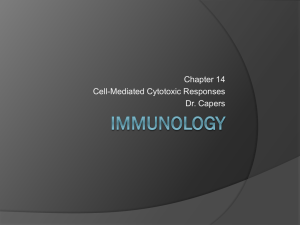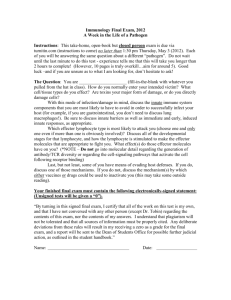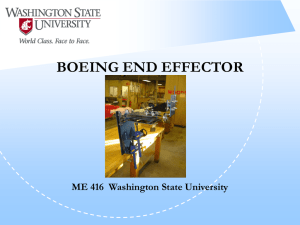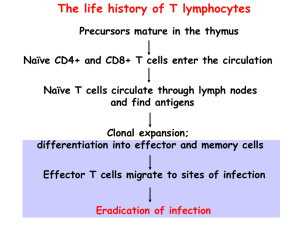Harvard-MIT Division of Health Sciences and Technology
advertisement
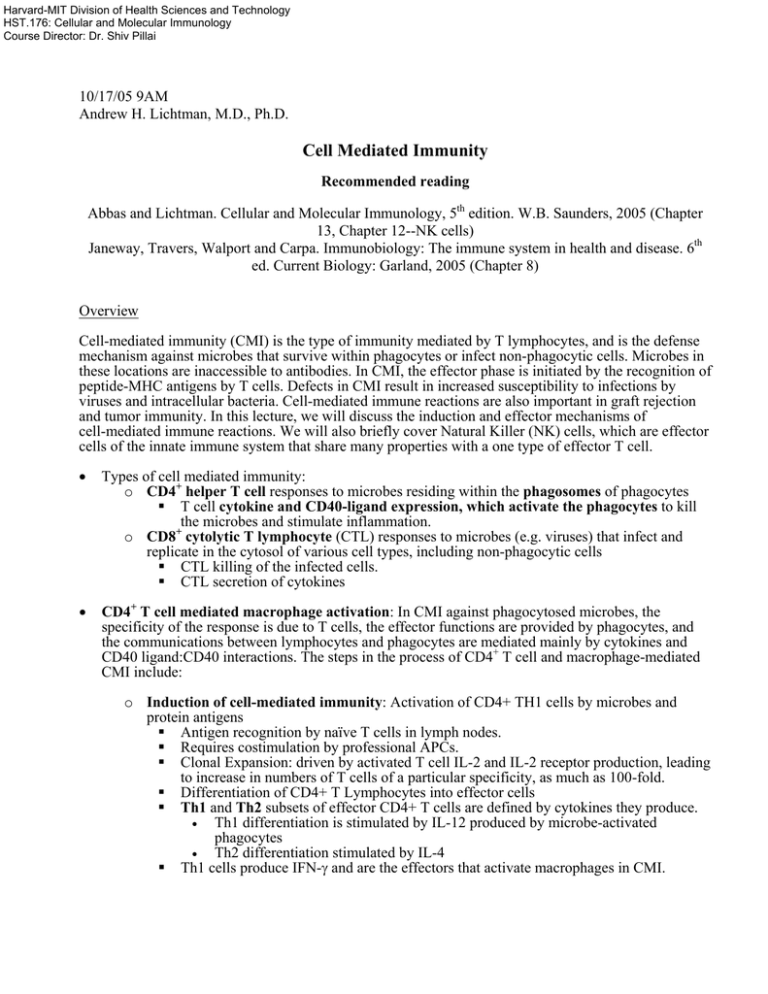
Harvard-MIT Division of Health Sciences and Technology HST.176: Cellular and Molecular Immunology Course Director: Dr. Shiv Pillai 10/17/05 9AM Andrew H. Lichtman, M.D., Ph.D. Cell Mediated Immunity Recommended reading Abbas and Lichtman. Cellular and Molecular Immunology, 5th edition. W.B. Saunders, 2005 (Chapter 13, Chapter 12--NK cells) Janeway, Travers, Walport and Carpa. Immunobiology: The immune system in health and disease. 6th ed. Current Biology: Garland, 2005 (Chapter 8) Overview Cell-mediated immunity (CMI) is the type of immunity mediated by T lymphocytes, and is the defense mechanism against microbes that survive within phagocytes or infect non-phagocytic cells. Microbes in these locations are inaccessible to antibodies. In CMI, the effector phase is initiated by the recognition of peptide-MHC antigens by T cells. Defects in CMI result in increased susceptibility to infections by viruses and intracellular bacteria. Cell-mediated immune reactions are also important in graft rejection and tumor immunity. In this lecture, we will discuss the induction and effector mechanisms of cell-mediated immune reactions. We will also briefly cover Natural Killer (NK) cells, which are effector cells of the innate immune system that share many properties with a one type of effector T cell. • Types of cell mediated immunity: o CD4+ helper T cell responses to microbes residing within the phagosomes of phagocytes T cell cytokine and CD40-ligand expression, which activate the phagocytes to kill the microbes and stimulate inflammation. o CD8+ cytolytic T lymphocyte (CTL) responses to microbes (e.g. viruses) that infect and replicate in the cytosol of various cell types, including non-phagocytic cells CTL killing of the infected cells. CTL secretion of cytokines • CD4+ T cell mediated macrophage activation: In CMI against phagocytosed microbes, the specificity of the response is due to T cells, the effector functions are provided by phagocytes, and the communications between lymphocytes and phagocytes are mediated mainly by cytokines and CD40 ligand:CD40 interactions. The steps in the process of CD4+ T cell and macrophage-mediated CMI include: o Induction of cell-mediated immunity: Activation of CD4+ TH1 cells by microbes and protein antigens Antigen recognition by naïve T cells in lymph nodes. Requires costimulation by professional APCs. Clonal Expansion: driven by activated T cell IL-2 and IL-2 receptor production, leading to increase in numbers of T cells of a particular specificity, as much as 100-fold. Differentiation of CD4+ T Lymphocytes into effector cells Th1 and Th2 subsets of effector CD4+ T cells are defined by cytokines they produce. • Th1 differentiation is stimulated by IL-12 produced by microbe-activated phagocytes • Th2 differentiation stimulated by IL-4 Th1 cells produce IFN-γ and are the effectors that activate macrophages in CMI. 10/17/05 9AM Andrew H. Lichtman, M.D., Ph.D. Th2 cells produce IL-4 and IL-5, which promote IgE and eosinophil-mediated antihelminthic responses. Th2 responses may also down regulate Th1 responses. TH1 differentiation is stimulated by IL-12 produced by APCs. o Migration of differentiated effector T cells and other leukocytes to site of antigen. The migration of leukocytes to sites of infection is stimulated by cytokines, which induce the expression of adhesion molecules on endothelial cells and the chemotaxis of leukocytes. Effector and memory T lymphocytes express adhesion molecules (intergrins, selectin ligands) that promote their migration to sites of infection and inflammation. The migration of effector and memory T cells from the circulation to peripheral sites of infection is largely independent of antigen, but cells that recognize antigen in extravascular tissues are preferentially retained there. o Activation of macrophages: Activated macrophages are the effector cells of cell-mediated immunity that function to eliminate microbes and other sources of antigen. T cell stimuli for macrophage activation include CD40 ligand and IFN-γ o Functions of activated macrophages: Killing phagocytosed and extracellular microbes, mainly by producing microbicidal reactive oxygen intermediates, nitric oxide, and lysosomal enzymes. Stimulate acute inflammation through secretion of cytokines, mainly TNF, IL-1 and chemokines, and short-lived lipid mediators, such as platelet-activating factor (PAF), prostaglandins, and leukotrienes. Remove dead tissues, facilitating repair after the infection is controlled. In addition to their effector functions, activated macrophages become more efficient APCs. • Delayed type hypersensitivity (DTH) is injury (rather than protection) caused by a helper T cell mediated immune response. This happens if the activated macrophages fail to eradicate the infection; T cells and macrophages continue to produce cytokines and growth factors, and this leads to progressive modification of the local tissue environment, including fibrosis. o Granulomatous inflammation is a form of chronic DTH with epithelioid macrophages, sometimes giant cells, and tissue fibrosis. Infection with Mycobacterium tuberculosis often leads to granuloma formation. • CD8+ T cells and cytolytic T lymphocyte (CTL) responses. Cytolytic T lymphocytes (CTLs) are effector T cells that recognize and kill target cells expressing foreign peptide antigens in association with class I MHC molecules. o Most cell types may be infected with viruses, but most cell types also express class I MHC and can process proteins by the class I MHC pathway. Therefore most cells can be targets of CTL killing. o Activation of naïve CD8+ T cells and development of effector CTLs Problem: The differentiation of naive CD8+ T cells to functional CTLs requires the recognition of class I MHC-associated peptides (“signal 1”) and costimulators and/or cytokines (“signal 2”) normally only present on professional antigen presenting cells. Solution: cross priming- a mechanism to ensure that naïve CD8+ T cells specific for the virus can be activated even when the primary infection is in cells that do not express costimulators, e.g. epithelial cells. 10/17/05 9AM Andrew H. Lichtman, M.D., Ph.D. o o o o o • Infected cells, debris form dying infected cells, or microbes released from the cells, are ingested by professional APCs. • Microbial proteins leave the phagosomes/endosomes (not known how) and enter the cytoplasm. • The microbial proteins are processed and presented by the class I MHC pathway. • Naïve CD8+ T cells specific for the peptide-MHC are activated by the professional APCs. Clonal expansion of CD8+ T cells in lymphoid tissues in response to viral infections often leads to as much as 50,000 to 100,000 fold increase in numbers of viral-specific CD8+ T cells. Peptide-MHC tetramers can be used as probes for expansion of viral peptide-specific T cells; this has been done with EBV and HIV infected patients. Differentiation of CD8+ T cells into effector T cells capable of cytolytic functions. Development of membrane-bound cytoplasmic granules that contain perforin and granzymes. Acquisition of the capacity to transcribe and secrete cytokines, mostly IFN-γ, LT, and TNF. o Mechanisms of CTL-mediated cytolysis: Cell killing by CTLs is antigen-specific and contact-dependent. CTLs kill targets that express the same class I-associated antigen that triggered the proliferation and differentiation of naïve CD8+ precursor of the CTL. Recognition of antigen on the target cell and activation of CTLs (does not require costimualtion) Accessory molecule interactions, including CD2:LFA3 and LFA-1: ICAM-1 strengthen conjugate formation between CTL and target. Delivery of a "lethal hit" by the activated CTL to its target. Granule exocytosis releases: • Perforin that forms pores in membrane of target cells. • Granzymes (serine proteases) that enter the target cell through the perforin pore and activate cellular enzymes called caspases, which lead to target cell apoptosis. • Fas ligand expressed on activated CTL may bind Fas on target cells and induce apoptosis. Cytokines (Th1-like) such as IFN-γ and TNF secreted by CTL promote inflammation. Release of the CTL: The CTL is not killed in the process, and can detach and find another target cell to kill. • Role of Th2 cells in cell mediated immunity o Suppression of Th1 mediated CMI by action of cytokines IL-4, IL-10, IL-13 which inhibit macrophage activation. o Promote inflammatory reactions, by secretion of IL-4 and IL-5, that are dominated by eosinophils and mast cells for protection against helminthic infections. IL-4 stimulates the production of helminth-specific IgE antibodies, which opsonize the helminthes and bind to mast cells. IL-5 activates eosinophils, which bind to the IgE-coated helminths by virtue of Fc receptors specific for the ε heavy chain. Activated eosinophils release their granule contents, including major basic protein and major cationic protein, which are capable of destroying even the tough integuments of helminths. • Natural Killer (NK) cells. NK cells are effector cells of the innate immune system that recognize and kill host cells which fail express some class I MHC molecules or kill host cells that express certain molecules indicative of intracellular infection or stress. 10/17/05 9AM Andrew H. Lichtman, M.D., Ph.D. o Many viruses may interfere with class I MHC expression and class-I pathway antigen processing, thereby rendering their host cells invisible to CTL. NK cells, however, “recognize” the absence of class I MHC and/or recognize cell surface molecules only expressed on stressed (e.g. infected) cells infection. o NK cells recognize” their target cells using both activating and inhibitory receptors. Activating receptors include CD16 (FcγR receptor), natural cytotoxicity receptors (unknown ligands), NKG2 (binds stress induced ligands) Inhibitory receptors include: CD94, ILT2, and Killer Inhibitory Receptors (KIRs), which bind class I or class I-like molecules. Inhibitory receptor signals suppress signals from activating receptors. o NK cells perform two major effector functions: Cytotoxicity: kill targets by same perforin/granzyme based mechanisms that CTLs use IFN-γ secretion-promote inflammation, and perhaps Th1 differentiation o NK cells play important protective roles against viruses (e.g. EBV), and perhaps other intracellular microbes. o Diseases characterized by lack of NK cells or NK function , such as X-linked lymphoproliferative disease (XLP) are associated with severe EBV infections and B cell neoplasm. XLP due to mutation sin gene encoding an adaptor protein in a signaling pathway involving the T-cell co-stimulatory molecule SLAM, and the NK-cell-activating receptor2B4. • Natural Killer T (NKT) cells. NKT T cell are numerically small subset of immune effector cells which develop as a separate lineage from, but share properties of both T cells and NK cells. o NKT cell recognize glycolipids presented by CD1d. o NKT cells recognize glycolipid/CD1 complexes via a TCR with an invariant T cell alpha chain. o NKT cells can secrete many different cytokines, rapidly after stimulation. o NKT cells can activate dendritic cells. o NKT cell activation may either suppress or stimulate immune responses. o Mouse models have indicated that NKT cell are involved in many different protective and pathological immune responses.
